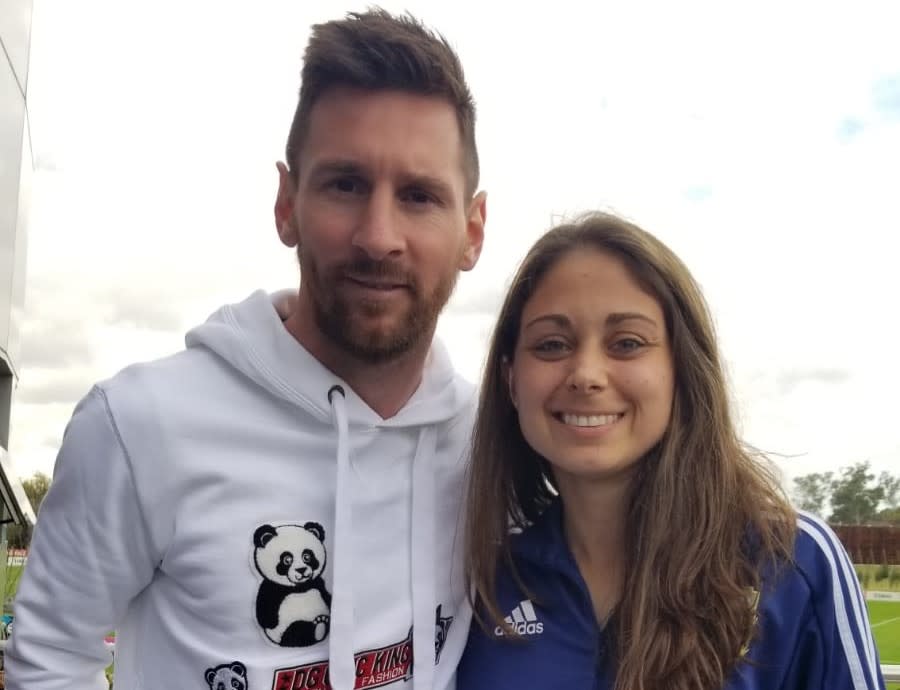How Argentina's national team went from non-existent to the Women's World Cup in two years
NEUILLY-SUR-SEINE, France — This time four years ago, the thought of Argentina vying for a spot in the knockout stage of the 2019 Women’s World Cup would’ve been downright laughable to American-born goalkeeper Gabriela Garton.
The team had failed to qualify for two consecutive tournaments, this after the humiliation of losing 11-0 to Germany at the 2007 event in China, the biggest margin of defeat for any team in World Cup history, men’s or women’s, until the U.S. trounced Thailand by 13 goals last week.
While the Lionel Messi-led men’s team was in the middle of a run to three consecutive major tournament finals, the Argentine Football Association had effectively given up on its women’s program in 2015 after the squad finished last in its group at the Pan American Games. That is, if the AFA had ever really supported it at all.
“From 2015 to 2017 the national team didn’t exist,” Garton told Yahoo Sports in an interview earlier this week just outside of Paris, where the Argentines will meet Scotland Wednesday with that unlikely place in the knockout stage somehow on the line.
Argentina has been one of the best stories so far at this World Cup. The Albicelestes Las Pibas tied Japan, FIFA’s seventh-ranked side, in their opener and then narrowly lost to No. 3 England in the second match. That means a win against the Scots will be enough to advance. Their stingy defensive performances against two of the title challengers have surprised even themselves.
“A little bit, yeah,” laughed defender Natalie Juncos, the other Argentine-American on the squad. Juncos is a Detroit native who spent three seasons at the University of Houston. “We played a bit more defensive the last two games to build the confidence that we can play against the best teams in the world. Now, we want to test it a little bit more offensively. We’ve had good results, but we want to take the next step.”

It’s astonishing that they’ve made it this far. Before the Japan match, Argentina hadn’t faced an international opponent since February. While the favored U.S. was preparing for the World Cup with a ballyhooed three-game send-off series, the Argentines scheduled tuneups against collegiate foes.
Still, things are a lot better than they used to be. When the squad reconvened in 2017, the AFA refused to pay for travel for players who lived more than 400 kilometers from Buenos Aires. One head coach was assigned to the under-17, U-20 and senior teams. Twenty-five women were forced to dress in a futsal locker room designed for 12. They wore threadbare practice gear that the men’s team had used a dozen years prior.
“We were being forced to train on the turf field at the [AFA] complex when there’s 10 other impeccable grass fields,” Garton said. “It was pretty much a mess.”
The players eventually went on strike to demand better treatment. The AFA had already been under intense pressure from the media for the better part of a year; fed up with the federation’s incompetence, or worse, Messi himself briefly retired from the national team following the loss to Chile in the final of the Copa America Centenario in 2016. The next day, AFA president Luis Segura was ousted on fraud charges by FIFA, which temporarily took over the organization.
Meantime, the women’s team didn’t train at all between the fall of 2017 and early last year. The strike had been a starting point for them, even made it into the newspapers. But the momentum quickly fizzled.
Soccer is like religion in Argentina. Passions run so high that when the top men’s club teams, Boca Juniors and River Plate, met last year in the South American final, fan violence forced the the decisive contest to be played on another continent. Traditionally, though, soccer in the nation of nearly 45 million has not been welcoming to girls and women.
When Juncos visited the country with her parents at age 12, just a few years after she watched the U.S. women hoist the 1999 World Cup, she was met with a shock. “Being that it was the most popular men’s sport in Argentina, I figured women’s soccer was just as high-level,” she said. “And then when I came down to train people looked at me weirdly. I didn’t know better.
“It was almost frowned upon,” she continued. “People would ask, ‘Where are your dolls?’ I’d be like, ‘What are you talking about, where are my dolls?’”
If they’re lucky enough to find a team that will take them, girls play against boys until they’re 13 or so. They’re often out of luck after that. With few opportunities, “It’s really common to see players just decide to give it up,” Garton said.
Even national team-level athletes sometimes simply walk away, frustrated by the endless struggle. Only about half of the World Cup squad are professionals, and the ones who are get paid a pittance of 4,000 pesos, or $92, a month.
So before a Copa America Feminina match against Colombia last year, the team decided to make another statement. During the traditional team photo before the match, all 20 players cupped their right hands behind their ears.

“Basically our message was we wanted to be heard by the association,” Garton said. The picture went viral. The results were immediate.
Suddenly, people were talking about the women’s team. The Copa matches weren’t televised; now World Cup qualifiers were being blasted across the country on free TV. The match that secured the Argentines’ ticket to France sold out within 24 hours.
Juncos missed most of 2018 because of injuries. When she returned to Buenos Aires from her home in Texas, she noticed a difference right away.
“When you walk in a park and you see pickup games, it used to be all men, and now there’s always a girl there,” she said. “It’s nice to be a part of that change.”
New AFA president Claudio Tapia has made the women feel valued. He’s been accessible; the players had never so much as seen Segura in the flesh. Before they set off for this World Cup, Tapia hosted a joint luncheon with the men’s team that was preparing for the Copa America in Brazil. It has forged a bond between the two sides. “That day we had lunch with them was pretty crazy,” Juncos said. “I couldn’t taste my food.”
The men’s team watched the tie versus Japan together at their hotel. Angel Di Maria and other male stars publicly voiced their support of their female counterparts before it, and others after, legitimizing the women’s game for many of the remaining holdouts.
“Various friends have told me that they’ve heard men talking about our game at a butcher shop,” Garton said. “That would never have happened before in Argentina.”
The ride isn’t over yet. There’s still at least one more game to go, more momentum to capitalize on, more hearts and minds to be won. The players are still striving for more, a lot more, but they know there’s only one way to get it.
“We can’t just say we want this and that,” said Juncos, who is hoping to latch on with a pro club in Europe or Asia when the World Cup is over. “We also have to win.”

More from Yahoo Sports:

 Yahoo Sports
Yahoo Sports 
